BidPlace: Bringing the construction industry together.
Creating an online collaboration platform for the construction industry where the hundreds of thousands of contractors, vendors and suppliers can collaborate and exchange bids under a no fee for use model.
The Problem: For every construction project, large or small, there are hundreds of different suppliers, contractors, vendors, and material manufacturers that exchange goods and services to make the project possible. In most cases, at every level of the project, each entity provides a bid to another entity to define the scope and cost of their portion of the work. These bids are most often competitive with multiple entities bidding for each piece of the project. The construction industry has been operating this way for decades with little change in how the process works. Communication channels, bid formats, qualifications and scope of work definitions are redefined for every project creating an inefficient process of collaboration. Furthermore, bid selections are largely based on relationships and past performance leading to an environment ripe for corruption and collusion.
Exhibit one illustrates a small portion of the players involved on any given project. This set of relationships illustrates all the entities involved with the purchase of light fixtures for the project. Each line between entities represents a purchasing decision based on price, qualifications, skills, and product attributes. On every project each of these must be bid, evaluated, selected, and negotiated. This process is largely recreated for the thousands of construction projects that occur in the United States alone every month. Imagine how many materials and services go into a project, leading to this same inefficient process being repeated hundreds of times for each project. There are millions of these exchanges happening every year.
The selection of contractors and vendors is very often driven by relationships as much as it is driven by price with each entity doing everything possible to maximize their profit. The same price for the same material is rarely given from project to project with pricing increasing based on how strong the relationship is between buyer and seller. There is a great deal of collusion between entities on every project.
There are many entities between the material manufacturer and the owner of the facility being constructed. The process for light fixtures, as an example, goes through the following entities: The fixture manufacturer sells to a wholesaler with a lighting sales agent in the middle being responsible for pricing and relationships to secure the project. The wholesaler sells to the electrical contractor who then sells the fixture to the general contractor. The general contractor finally sells to the owner. There is a price markup at every stage leading to the owner paying at least twice what the fixture originally cost from the manufacturer.
Some construction bidding opportunities are currently offered on pay for service platforms. The fees for these platforms start at thousands of dollars per year. Nearly every construction project includes at least some small businesses that simply cannot afford to subscribe to these services. Furthermore, to see every opportunity, subscription to multiple services would be necessary. For this reason, there is no widespread adoption to any single bidding service. Most contractors and vendors do not find value in these services and do not use them. Instead opportunities are communicated through word of mouth and relationships. This creates a significant barrier to entry for new entrants into the market as well as a reduction in competition.
There does not appear to be any viable non-subscription options in the market today.
The solution: Create a social network platform where contractors, suppliers and vendors can connect and exchange bids. There will be no fee for subscription, no exclusivity for project posting or other barriers to the use of the platform. This will drive adoption and create an industry standard way for the different entities to interact. The value capture for the system will be through targeted advertising and construction data collection.
As an example of data collection value capture, contractors are paying thousands of dollars for construction estimating software . The current offerings do not offer the necessary granularity for all entities on a project and do not have up to date estimates following rapidly evolving market conditions. Bidding through BidPlace would allow collection of accurate cost data that will be sold through a cost estimating subscription service that is always up to date. There are many other opportunities to create value from data collected.
Additional services provided on the platform will include a standard approach to pre-qualification for contractors, contractor reputation systems, and user developed bid and prequalification forms to allow each entity to gather the information they need to make a selection for each particular interaction. Additional future collaboration and communication tools that support the construction process through the life of the project could also be developed.
Key technologies on the platform will include artificial intelligence that will ensure that each subscriber sees only the opportunities that are relevant to them while blocking out spam and other unsolicited advertisements that are not true project opportunities. Secure data storage will be required as a repository for construction drawings and other documents that are necessary to define the scope of work. AI algorithms will also be used to display targeted paid advertising to subscribers. A reputation system will be included for contractors and vendors that can be used for contractor selection.
This platform will increase accessibility for buyers and sellers to connect which will increase competition in the construction market. The reputation system will drive contractors to have to perform to maintain their ability to get work. The result will be increasing construction quality at a decreasing cost. With the construction industry estimated to make up 4.1% of the American GDP (statista.com) this will have the effect of creating an overall stronger economy for the nation. The efficiencies gained in the collaboration between entities will allow them to maintain their margins.
The target market for this service will be all contractors, facility owners, material manufacturers and other entities in the construction market. The construction market in 2019 is estimated to be $1.3 trillion and is expected to grow to $1.5 trillion by 2023 (exhibit 2). For contractors alone there are estimated to be over 680,000 different companies employing over 7 million people (Association of General Contractors).
The BidPlace team: This concept is in its early stages. A team consisting of construction experts and computer and data scientists to develop the platform is needed. A partner to develop the platform and key AI algorithms is the priority to drive development.
The creation of this platform will bring the construction industry together and into the 21st century. Over the last hundred years there has been little disruption to the construction industry, it is time for a change.






I think this is an amazing idea; to level the playing field and create a standardized platform from bid-to-build, so that a lot of the slack can be taken out of the system would create tremendous value. It would also assist on at least a national basis as construction “moves” from the bust to boom areas of the country. (For example, electrical contractors relied on “travelers” from other states to work in Oregon in the mid-90’s, and contractual provisions had to take that into consideration. My background is in employee benefits and (beyond to Systems Development work I started with) I’ve represented Labor-Management Trust funds for both Taft-Hartley (Union) Trades and also state governmental plans such as OPERS and WA state. Having worked with NECA/IBEW, the Sheet Metal, Glaziers and Ironworkers, creating an interface that embedded the local collective bargaining agreements, as well as the Federal (Davis Bacon, etc.), as well as the liability provisions for costs that may flow through to the owner, etc. would be significant.
In Oregon, for example, we were able to establish that all the items in the CBA were included as “wages” for purposes of the lien statute. As a result, we were able to collect retirement contributions from the owner of a project from a defaulting electrical subcontractor, because those debts fell through to the owner. The example simply highlights the legal issues involved with needing to know who you’re dealing with. As this was new law, the owner that developed the property thought that liability for the IBEW members stopped at the contractor. In any event, just an added “interface,” so-to-speak, to your bubble chart, but maybe both financially and politically necessary. (Meaning, if AGC is behind it, it might be helpful to get the national construction trades workers as well.)